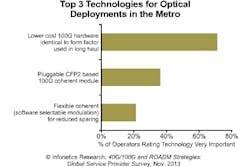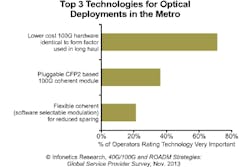Infonetics survey says volume metro 100G coming in 2016
Last year, Infonetics Research told us that 100G wavelengths would take over in the core by 2015. Now, in the latest edition of its global service provider survey, the market research firm reports that operators believe 100G will arrive in volume in metro networks the following year.
In a new report, "40G/100G and ROADM Strategies: Global Service Provider Survey," Infonetics details the results of a survey aimed at uncovering how operators plan to transition optical transmission and switching equipment to higher-speed 40G and 100G wavelengths.
The move to 100-Gbps coherent transmission in the core is well underway. "The next big questions around 100G optical technology are about deployments in the metro network," said Andrew Schmitt, principal analyst for optical at Infonetics Research. "When will deployments kick in, what will the volume be, which technologies will make the transition possible – advanced modulation, Raman amplification, pluggable formats, non-coherent approaches? We asked service providers around the world these questions and many more in our latest optical survey, and we learned a lot about what is about to happen in the market."
Schmitt added, "We now know, for example, that based on current operator thinking, 2016 will be the year that coherent 100G technology arrives in volume in metro networks. That is also when we expect cost-per-gigabit pricing for 100G to edge out 10G in shorter-reach applications."
The key word here is “volume.” Most of the major systems houses have told Lightwave that their current 100G systems are finding deployments in metro and regional applications already.
Infonetics' survey shows that, based on respondent ratings of various technologies for optical deployments in metro regional networks, most operators prefer the same approach they already use in the long haul in the metro, albeit with lower specs and cost. Most new technologies designed to address the metro 100G opportunity (not all are shown in the chart below) were rated highly by only a few respondents.
"Right now what most people want is just what they have now, only cheaper," said Schmitt. This would imply that direct-detect approaches will prove to be a niche technology – or popular among customers not polled in the survey.
For its 26-page 40G/100G and ROADM strategies survey, Infonetics interviewed 28 incumbent, competitive, mobile and cable operators from Europe, North America, Asia and Latin America that have an optical transport network using WDM. Together the respondents represent about 40% of the world's telecom capex and revenue.
For more information on high-speed transmission systems and suppliers, visit the Lightwave Buyer’s Guide.

